Jammer Enforcement Actions at FCC
In the above “landmark enforcement action” FCC issued a Notice of Apparent Liability(NAL), i.e. a fine, against a Chinese jammer company for marketing in the US by way of Internet and some unidentified shipping mechanism, “285 different models” of jammers targeted at cellphones, GPS, Wi-Fi, Bluetooth, etc. The amount of the proposed fine is $34,912,500! However, none of this goes to FCC and it is unlikely that any of it will ever be paid in any case.
Lest you think this is the only Chinese company doing this, your blogger has received dozens of e-mail ads for such devices from a different firm and has routinely forwarded them to FCC/EB. So clearly C.T.S. Technology is not the only offender.
Para. 5 of the new NAL states
“We also again warn U.S. consumers that importing a cell, GPS, or other signal jammingdevice (i.e., purchasing such a device online and having it shipped into the United States via the U.S. mail or other transport or courier service) is unlawful and may subject them to civil and criminal penalties.”
This is followed by a citation to fn. 4 which cites 18 U.S.C. § 1362 and 18 U.S.C. § 1367(a) as well as the 2010 Phonejammer.com FCC NAL. The only problem is that the 2 cited laws have nothing to do with ordering jammers - they deal with actually jamming a federal communications system or a communications satellite - something unlikely with the jammers involved here, but remotely possible. (The cited Phonejammer also has nothing to do with ordering jammers.) So was this section of the NAL sloppy legal work in EB or is there a legal ambiguity under present statutes on the issue of importing jammers for personal use? It is clear that § 333 forbids actual jamming of licensed/authorized transmitters:
No person shall willfully or maliciously interfere with or cause interference to any radio communications of any station licensed or authorized by or under this chapter or operated by the United States Government.
The cellular industry prefers to read § 333 as forbidding FCC from ever authorizing any jamming, even in remote prisons. Thus they were successful in stopping FCC from even asking for public comment on the GTL petition on both jamming and “managed access” - notwithstanding the § 1.403 requirement to issue “promptly” a PN asking for comments on such petitions. They even managed to get FCC to draft the Docket 13-111 NPRM to exclude any discussion about what is the scope of § 333 even though this rulemaking is partially responsive to the GTL petition.
The cellular establishment is betting that its interpretation of § 333 will be able to drive all jammers from US territory. However, as we have stated repeatedly, there is a demand for jammers that arises from perceptions of antisocial use of communications. While there are some possible uses of jammers that are beneficial financially to the perpetrator of such use, (e.g. a hotel owner jamming cellphone to force use of expensive hotel room calling services), in practice such use is very rare. Most cellular jamming and GPS jamming is in response to perceptions of antisocial behavior or invasions of privacy. Until the cellphone and GPS industry address those perceptions about the harmony of using their products and the impact on others there will always be consumer demand for jammers. Discussing nonexistent laws that ban consumer ordering of jammers, as in para. 5 of the NAL, or banning all prison jamming use under a specious interpretation of § 333 may feel good to the cellular industry, but are doomed to be ineffective.
Hopefully this NAL might spur Customs and Border Protection to try harder to intercept jammers on their way to the US and might spur carriers like FedEx to ask more questions from shippers like C.T.S. Technology.
UPDATE
Our friends at CommLawBlog, who actually are lawyers when not blogging, also have questioned the legal basis of this NAL stating:
We also can’t help questioning the extent to which C.T.S. actually violated the law.
True, it shipped ten devices to U.S. addresses, but it performed its acts in China, where it may be perfectly legal to ship jammers to U.S. addresses. One unquestionably unlawful step in the transaction was the importation of the ten devices – but FCC staffers, not C.T.S., did that by initiating the transactions and accepting delivery.
Penalizing C.T.S. for the 275 models that it advertised but did not ship to the U.S. is even more tenuous. There is only one Internet; a company cannot easily promote its products on line in some parts of the world but not others. The FCC’s best arguments are probably that (a) some of the advertised products jam wireless frequencies used only in the United States and (b) the company quotes prices in U.S. dollars. True, C.T.S. could refuse to fill U.S. orders and could display a notice on its website stating that policy. But the failure to have the policy and to display the notice may not add up to an actionable violation.
To be clear: C.T.S.’s jammers are disruptive and potentially dangerous. We agree with the FCC that they have no place in the United States. We fully support the FCC’s efforts to keep them out of the country. We just wish the FCC could manage it from a more secure legal platform.
So if the goal is to actually stop the sale and use of such jammers in the USA, not just to posture to the cellular industry, perhaps some more pragmatic actions are needed.
Field of Dreams & Spectrum Policy
This week, the 80th anniversary of the Communications Act of 1934, is also the 25th anniversary of “Field of Dreams”, the movie most remembered for the line “If you build it … they will come”. While I recall that President Bush (41) publicly said he was confused about the movie, President Bush (43) actually was a great fan.
The connection to spectrum policy? Classic FCC spectrum policy (along with spectrum policy in other places) was prescriptive - that is users could do A and B, but not C if C was not explicitly allowed. Thus when I joined FCC in 1979, land mobile (Part 90) users were allowed AM and FM modulation and it took a long series of rule makings, some of which inconsistent in their final technical details details, to allow digital modulation for all users. By contrast, today’s rules are generally (broadcasting and public safety being major exceptions) proscriptive in that they tell you what you may not do - generally things that would result in interference to other users.
The reason why the 1981-85 rulemaking that brought forth Wi-Fi, Bluetooth, ZigBee and many other less known products was so controversial that it resulted in an attempt to fire your blogger after the rules were adopted was that it was an earlier action to move away from this prescriptive model. The rules adopted in Docket 81-413, now updated and codified as 15.247, did not say “let there be Wi-Fi”, they said “here is this spectrum, here are rules that prevent harm to anyone else, feel free to innovate and offer new products to the public and let’s see where this goes! “ (In truth, in 1985 wired/Ethernet LANs were nonexistent in offices and homes and there are no interest in any type of wireless LAN as a product for serial production. But the flexibility grand in the Docket 81-413 R&O meant that when interest developed for RLANs within a few years those interested did not have to come to FCC and grovel for permission for years. Thus they had timely market access and history was made!)
So as we near the 1 year anniversary of the IEEE-USA petition for FCC on the spectrum above 95 GHz that now lacks any rules (and is hence implicitly forbidden for normal licensed or unlicensed use) today let us ponder what we gain by having no such rules or even a defined path to such rules. In the Docket 81-413 rulemaking most commenters were opposed saying the technology under discussion was “blue sky” and had no demand. Yet within 2 years commercial products were available. A few years later came Wi-Fi and Bluetooth -- now “applications that have changed our world”.
Let us ponder of the lessons of “If you build it … they will come” and also the spectrum policy variant: “If you allow it .. they may well build it”. Let’s see if we can convert most FCC spectrum rules from prescriptive to proscriptive structure. (The cellular rules generally have this approach already.)
ABC US News | ABC Celebrity News
FCC@80
According to the FCC’s first annual report in 1935, here are the key dates
- June 19, 1934 - Passage of the Communications Act
- July 11, 1934 - Swearing in of the first commissioners (7 in number until the 1980s)
- July 17, 1934 - First commission meeting
When FCC was created in 1934 the world was much simpler than today and the FCC had a somewhat different structure than today although it was not reflected in the statute. Like the Interstate Commerce Commission that was the predecessor to the FCC’s Title II jurisdiction, the initial 7 commissioner FCC divided itself into 3 “divisions” of 3 commissioners at creation in 1934 – dealing with: telephone, telegraph, and radio. The original intent was that the whole commission would meet en banc for issues affecting multiple industries or key decisions. Note that this was prior to the 1946 Administrative Procedures Act (APA) when the procedures for adopting and enforcing rules lacked today’s checks and balances, but were also much faster. Note also that prior to World War II the maximum frequency of practical use and the number of technological options for radio technology were very limited. While the 1934 FCC Annual Report mentioned in passing the “possibility” of VHF use “above 30 megacycles” or what would be called 30 MHz today, the highest frequency mentioned in actual routine use was 2.5 MHz.
At the same time of the arrival of the APA in 1946 came the postwar rapid explosion of available spectrum for practical use, many new technologies for using that spectrum, and an ever expanding categories of uses that have benefited both our economy and our society. But is the FCC, as presently structured able to deal with this workload efficiently? Experience shows that technical spectrum policy decisions are just not keeping up to the pace of today’s complex industry. While major players are able to demand timely action on some issues, e.g. DTV transition and incentive auctions, even these major players have to choose between which of their actions will get attention in a sort of informal rationing system. Entrepreneurial firms that are the hot bed of innovation in other technical areas just do not have access to much of the FCC’s limited decision-making throughput in the spectrum policy area and as a result get turnaround on technical policy issues that discourages investment in wireless technology requiring nonroutine FCC approvals. Even major incumbents are not getting a timely response of new unanticipated types of interference to their systems that need rulemaking action to resolve.
Your blogger has fundamental doubts whether today’s FCC as presently structured has the decision making throughput to do its basic spectrum management functions in timely way while faced with simultaneous issues such as incentive auction, net neutrality, and several megamergers. We believe that if the Commission will recognize this shortfall that it has the flexibility under Section 5(c) of the original Communications Act to increase its throughput by delegating more technocratic issues to the staff as its UK counterpart Ofcom does under the policy guidance of its “Board” which is analogous to the FCC commissioners. The Ofcom Board delegates most actions to its senior staff while maintaining policy control.
(We note that in Canada the politically sensitive issues of most interest to the 8th Floor are handled in the FCC-like Canadian Radio-television and Telecommunications Commission, while most technocratic issues are handled by the less politicized Spectrum, Information Technologies and Telecommunications sector of Industry Canada. While a Canada-like dichotomy would require legislation, much of the UK Ofcom functionality and improved productivity could be achieved under the terms of Section 5(c).)
We hope that FCC and the spectrum policy community will use this anniversary to contemplate whether the presently structured FCC is adequately keeping up to the task at hand in spectrum policy or whether the commissioners should use their Section 5 power to delegate more functions that they do not personally add value to.
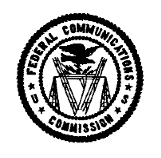
Original FCC seal in 1934
"Back Office" Problems at FCC and the Net Neutrality Rulemaking
Your blogger was preparing for a presentation this week to a group of engineering interns in DC on “Admin Law for Techies” and was going to use the regulations.gov website to show how to find NPRMs from various agencies and watch the rulemaking process. He decided to use the net neutrality rulemaking as an example since it is probably the most visible rulemaking on a technical issue in the whole government at the moment. Going to the government-wide regulations.gov website resulted in the screen shown above. Why?
A little snooping showed the root cause of the problem is a “back office problem” at FCC. This is a problem that is been ongoing under several chairmen from both parties. A lot of attention is spent on Commission open meetings (held at the statutory minimum of 1/month in recent decades - there used to be 1/week). Bureau chiefs and senior managers get a lot of attention. But the junior civil career servants who perform the key functions of final polishing of FCC decisions and getting them out the door so they can go into effect continue to be understaffed, overworked and underappreciated.
So it is not surprising that a key FCC NPRM like net neutrality languishes in publishing limbo. Does it matter? Well, normally FCC NPRMs have a comment period tied to Federal Register (FR) publication date. The net neutrality NPRM unusually has a comment date on the FCC-released version of July 15. What happens if it does not make the Federal Register before then? What happens if it is only published a few days before 7/15? Might a court rule that commenting period was inadequate since Federal Register publication is the formal announcement? A senior FCC manager I discussed this with insisted it was of no significance.
However, a similar problem happened last year with the experimental license reform rulemaking, Docket 10-236. As shown below where FCC boasted about making “significant changes to its Part 5 Experimental Radio Service (ERS) by creating a more flexible framework to support the rapid pace of technological innovation and to further implement the recommendations of the Commission’s March 2010 National Broadband Plan”:
While the text of the decision was released the same day it was adopted - a sign of a high priority action - effectiveness dates of all new federal rules (with a few narrow exception) are tied to FR publication. This decision was not published in the FR until April 29, 2013, making the effectiveness date of the new rules the end of May. It is unclear how much of this 88 day delay was last minute edits and 8th Floor review of them or coordinating with the Federal Register details of the publication. However, it is reasonable to assume that the “back office” problem was a key contributor to the delay and the implementation of the new rules.
To make matters worse, after the press release’s selfcongratulatory tone on the new rules, a key aspect of the new rules involving “program experimental licenses” is still not in effect almost 16 months after the above press release because FCC has lacked the funding to update its online filing system for experimental licenses - a “state of the art” Clinton Administration design that is hated by all those who use it - both inside and outside FCC.
So it is nice to do grand things like net neutrality and experimental license system changes, but resources are needed for the unglamorous side of FCC to make such glamorous actions effective. We suspect that the root of this is the longstanding over politicization of the FCC staff with too many senior managers coming and going with 8th Floor changes. The career staffers who deal with ministerial problems of keeping rule makings moving and implementing them are not getting the attention and resources needed to do their jobs. As we have discussed previously in the context of awards at FCC, they are also not getting the recognition from senior leadership and the public.
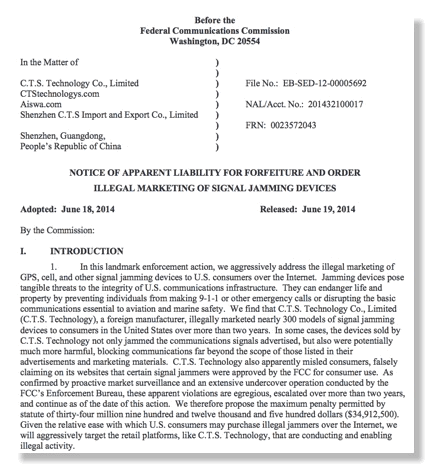
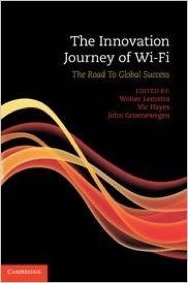
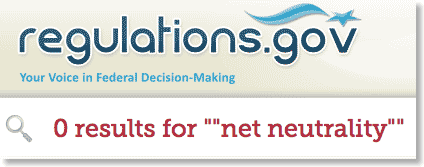
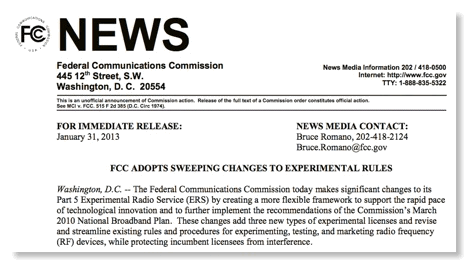



![Validate my RSS feed [Valid RSS]](valid-rss-rogers.png)

